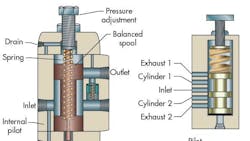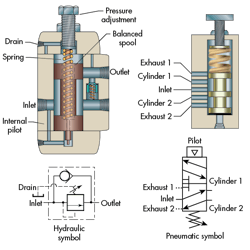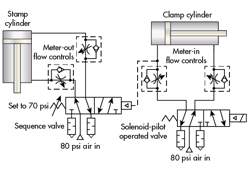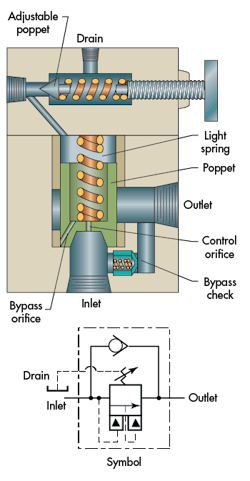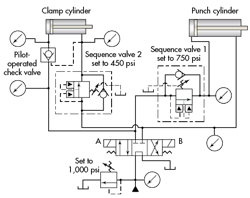When Should You Use Sequence Valves?
This file type includes high-resolution graphics and schematics when applicable.
The simplest way to make two or more cylinders stroke in a planned sequence is by using a single directional valve. However, when two or more cylinders are piped in parallel, the cylinder with the lowest resistance will stroke first. If this is the intent, the circuit runs smoothly without other valves. However, in most cases, loads change, so if you want cylinders to stroke in a specific order regardless of the load on each, you’ll need more than just a single directional valve.
The only positive way to do this is with separate directional control valves and limit switches or limit valves. This setup ensures the first actuator has reached a specific location before the next operation commences. However, the first cylinder may lose holding power when the second directional valve shifts.
If there is no safety concern or possibility of product damage if the first actuator does not complete its cycle before the second starts, a sequence valve can be a simple way to control the actuators’ actions. Sequence valves are normally closed, and they usually incorporate an integral bypass check valve to allow bidirectional flow. Sequence valves always have an external drain connected directly to tank.
On the other hand, one great feature of a sequence-operated circuit is that it does not matter how far the first cylinder moves before the next operation takes place. Thick or thin parts are clamped at the same force before the next operation starts because pressure must build to the same level to trigger the next sequence.
Getting to Know Sequence Valves
Figure 1 shows symbols and cutaways for hydraulic and pneumatic sequence valves. The main difference between these valves is that most hydraulic sequence valves are single purpose and must be used in series with a directional control valve. However, many pneumatic sequence valves are pilot-operated directional control valves with an adjustable spring return. In either case, a preset pressure must be reached before the valves allow fluid to pass or change flow paths. Many manufacturers offer a direct-acting, internally piloted hydraulic sequence valve like the design shown in Fig. 1. This valve can be changed to external pilot in the field if required.
Many manufacturers also offer pilot-operated sequence valves. Pilot-operated sequence valves stay closed to within 50 psi or less of their set pressure. Direct-acting sequence valves may partially open at pressures that are 100 to150 psi below set pressure—and, thus, allow premature actuator creep.
A balanced spool—held in place by an adjustable-force spring—blocks fluid at the hydraulic sequence valve’s inlet. When pressure at the inlet reaches the spring setting, pressure in the internal pilot line pushes the spool up to allow enough flow to the outlet to keep pressure from climbing. Pressure at the inlet never drops below set pressure when fluid (oil or air) flows to the outlet. When outlet pressure exceeds set pressure, the valve opens fully, and pressure at both ports equalizes. The drain port hooked to the tank must be at no pressure or constant pressure because any pressure in this line adds to the spring setting. Again, a sequence valve always needs an external drain.
A bypass check valve accommodates reverse flow when the valve is used in a line requiring bidirectional flow. A sequence valve may be externally piloted from another operation in some applications. Most valves can be converted in the field. (The technician should always change the part number to reflect the conversion.)
Whether sequence valves are used with compressed air or hydraulic fluid, keep in mind that sequence valve shifts on a pressure build up and may start a second operation prematurely if an actuator stalls or is stopped for any reason. Don’t use sequence valves if personnel safety or product damage can occur due to an incomplete stroke. Instead, use limit switches or limit valves and directional control valves for each operation sequence.
Flow controls in sequence valve circuits must be the meter-in variety. The signal to the sequence valve should come from the line downstream of the flow control because pressure at this point will be whatever it takes to move the cylinder and its load.
Coming Up for Air
Pneumatic sequence valves typically are five-way directional control valves with adjustable springs to set their shifting pressure. They are used to start a second operation after the preceding one finishes. Some older machines have one solenoid valve to start a cycle and several sequence valves to extend and retract all other actuators.
Whether they’re used with compressed air or hydraulic fluid, keep in mind that sequence valve shifts on a pressure build up and may start a second operation prematurely if an actuator stalls or is stopped for any reason. Don’t use sequence valves if personnel safety or product damage can occur due to an incomplete stroke. Instead, use limit switches or limit valves and directional control valves for each operation sequence.
The circuit in Fig. 2 is typical for air-powered machines. The clamp cylinder extends to clamp a part when an electrical input signal shifts the solenoid pilot-operated valve. As it extends, pressure beyond the meter-in flow control at the clamp cylinder’s cap end becomes as high as necessary to move the piston and its load. With the sequence valve set to shift at 70 psi, the stamp cylinder should not move until the clamp cylinder has extended and securely clamped the part. If the clamp cylinder does not achieve its full stroke for any reason, the stamp cylinder will extend prematurely but not damage the part or be unsafe. When pressure in the clamp cylinder reaches or exceeds 70 psi, the sequence valve shifts to extend the stamp cylinder. Both cylinders can return simultaneously with no issues.
Flow controls in sequence valve circuits must be the meter-in variety. They take the signal to the sequence valve from the line downstream from the flow control because pressure at this point will be whatever is required to move the cylinder and its load. However, the stamp cylinder in Fig. 2 has meter-out flow controls to retard its movement and hold pressure on the clamp cylinder during the stamping operation. De-energizing the solenoid pilot-operated valve allows both cylinders to return home at the same time.
Sequencing Hydraulics
The hydraulic sequence circuit in Fig. 3 is typical for a machine that must clamp and hold pressure while a second operation takes place. Sequence valve 1 is set at 550 psi; pressure at the clamp cylinder must be at least 550 psi before the punch cylinder can extend. Pressure in the circuit never drops below 550 psi while the punch cylinder is extending. If the punching operation requires more than 550 psi, the pressure in the whole circuit will increase all the way up to the circuit’s relief valve setting.
Sequence valve 2 (set at 450 psi) keeps the clamp cylinder from getting a retract signal until the punch cylinder has returned and pressure increases. A pilot-operated check valve maintains clamp force while the punch cylinder retracts. The signal to open the pilot-operated check valve comes from the line between Sequence Valve 2 and the clamp cylinder, so no signal occurs until the punch cylinder fully retracts. (This circuit is not safe if pressure buildup comes from a source other than clamp contact or the end of stroke because the punch cylinder would extend prematurely.)
Just for Kicks
Sequence valves often generate heat because the first actuator to move takes higher pressure than the subsequent actuators. This means a high pressure drop usually occurs across a sequence valve, resulting in wasted energy. In some circuits, a kick-down sequence valve can reduce the energy loss. The cutaway view and symbol in Fig. 4 show the inner workings of a kick-down sequence valve to explain how it controls opening pressure and then unloads it.
Fluid from the inlet flows through the control orifice and up to the adjustable poppet where it is blocked. The resulting pressure tends to open the main poppet, while equal pressure and a light spring acting on the opposite side hold it shut. When pressure increases enough to unseat the adjustable poppet—and more flow starts passing the main poppet than going through the control orifice—the pressure imbalance lifts the main poppet. When the main poppet moves enough to release trapped fluid through the bypass orifice, pressure on top of the poppet recedes because the bypass orifice is larger than the control orifice. At this point, the only force acting to hold the poppet shut is spring force and backpressure at the outlet port. When flow stops, the poppet closes again due to pressure equalization and spring force on the poppet.
The circuit in Fig. 5 is the same as in Fig. 3 except it incorporates kick-down sequence valves in place of standard sequence valves. The punch cylinder will not extend in this circuit until pressure on the clamp cylinder has reached 750 psi. The difference is when a kick-down sequence valve opens at its pressure setting, it allows fluid to pass at 50 psi plus whatever it takes to overcome downstream resistance. This means the whole circuit from the pump to all actuators is 50 psi plus the punch cylinder’s resistance. The pilot-operated check valve at the clamp cylinder’s cap-end port keeps it pressurized at near full force while the punch cylinder extends at low force. Energy waste becomes very low, so heat buildup is minimal.
This material was excerpted and edited from the Fluid Power Basics section of our website.
